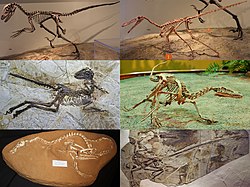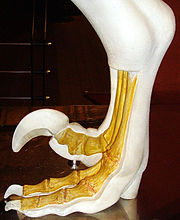
Back Dromaeosauridae Afrikaans درومايوصوريات Arabic Dromeozavridlər Azerbaijani Dromeosàurids Catalan Dromaeosauridae CEB Dromaeosauridae Czech Dromaeosauridae Danish Dromaeosauridae German Dromaeosauridae English Dromeosaŭredoj Esperanto
| Dromaeosaur | |
|---|---|

| |
| A collection of dromaeosaurid fossil skeletons. Clockwise from upper left: Deinonychus (a heavily built dromaeosaurine), Buitreraptor (a long-snouted unenlagiine), Velociraptor (a small velociraptorine), Microraptor (a winged microraptorian), Halszkaraptor (a semiaquatic halszkaraptorine), Zhenyuanlong (a long-winged dromaeosaurid) | |
| Scientific classification | |
| Domain: | Eukaryota |
| Kingdom: | Animalia |
| Phylum: | Chordata |
| Clade: | Dinosauria |
| Clade: | Saurischia |
| Clade: | Theropoda |
| Clade: | Eumaniraptora |
| Family: | †Dromaeosauridae Matthew & Brown, 1922 |
| Type species | |
| †Dromaeosaurus albertensis Matthew & Brown, 1922
| |
| Subgroups[1] | |
| Synonyms | |
| |




Dromaeosaurs are a family of bird-like theropod dinosaurs. They include the famous Velociraptor and Deinonychus. They were small to medium-sized feathered carnivores which flourished in the Cretaceous period.
They are often called raptors,[2] a term popularized by the movie Jurassic Park. They were fast-running predators.
Dromaeosaurs eventually had a world-wide distribution.[3] Isolated teeth suggest they first appeared in the Middle Jurassic, 167 million years ago (mya). But more complete records are not found before about 124 mya in the Lower Cretaceous. They spread to all continents. The group survived until the end of the Cretaceous, 65.5 mya at the K/T extinction event.
Although dromaeosaur teeth have been found in the Middle Jurassic, no dromaeosaurid body fossils have been found this early.[4]
- ↑ Holtz, Thomas R. Jr. (2012) Dinosaurs: The Most Complete, Up-to-Date Encyclopedia for Dinosaur Lovers of All Ages, Winter 2011 Appendix.
- ↑ Acorn J. (2007). Deep Alberta: fossil facts and dinosaur digs. University of Alberta Press. pp. 13. ISBN 978-0888644817.
- ↑ Case J.A; Martin J.E. and Reguero M. 2007. A dromaeosaur from the Maastrichtian of James Ross Island and the Late Cretaceous Antarctic dinosaur fauna. Pp. 1–4 in Cooper A. Raymond C. and Team I.E. (eds) Antarctica: a keystone in a changing world. Online Proceedings for the Tenth International Symposium on Antarctic Earth Sciences, U.S. Geological Survey Open-File Report 2007-1047, SRP 083. U.S. Geological Survey, Washington D.C.
- ↑ Metcalf S.J.; et al. (1992). "A new Bathonian (Middle Jurassic) microvertebrate site, within the Chipping Norton Limestone Formation at Hornsleaslow Quarry, Gloucestershire". Proceedings of the Geologists' Association. 103 (4): 321–342. doi:10.1016/S0016-7878(08)80129-0.